While one former Liverpool player, Xabi Alonso, is arguably the hottest property in the football coach market at the moment, with two of his former clubs — the Reds and FC Bayern — heavily linked with leading them from next season, another LFC alumnus, Albert Riera, is quietly forging an impressive managerial CV in his own right.
The 41-year-old Spaniard already has silverware to his name, having led NK Olimpija Ljubljana to a domestic double last season with the Slovenian Cup and Slovenian top-flight title both claimed in what was the young manager’s only season at Stožice Stadium.
Riera moved to Olimpija’s stiffest domestic competitors, NK Celje, last summer after they’d finished second to his league winners the season prior and remained in charge for 17 games — 12 in the league — departing in October with the club sat top of the table in order to assume the hot seat at Ligue 2 Bordeaux, another of his former clubs as a player.
On taking charge of Bordeaux, Riera was walking into a club that had won just one of their last six league games. At the time of writing this article, the Spanish coach has led Les Girondins to four wins and one draw in their last six, with Bordeaux sitting second on the Ligue 2 form table for this period of time.
This tactical analysis piece will focus on Riera’s early impact at Bordeaux, providing some analysis of the team’s tactics during his tenure compared to before, including player roles and principles of play. We’ll highlight where Riera has overseen improvement and what he’s done differently from his predecessor.
What’s Riera all about?
One of our senior analysts, Domagoj Kostanjšak, provided an excellent analysis of Riera’s Olimpija team last year, which is highly recommended reading if you enjoy this piece, perhaps even as a precursor.
In that tactical analysis, among plenty of other insight, Riera’s heavy commitment to positional play principles and a positional play philosophy, efficient counterattacking, penetration via the half-spaces, frequent positional rotations and intelligent off-the-ball movement were all mentioned as evident features of a thrilling Olimpija Ljubljana side.
All of the above has also only become more and more apparent within this Bordeaux team as Riera’s tenure has progressed.
Still, Riera and his teams shouldn’t be put into any particular box or branded as ‘this type of team’ or ‘that type of team’. Flexibility is another vital element of Riera’s sides, and while general principles typically remain consistent, tactics will vary from opponent to opponent to a certain extent.
Bordeaux are the most possession-based side in France’s second tier, but they have kept marginally less possession under Riera than they did under his predecessor, David Guion, this season — 57.2% vs 59.1%.
It’s ultimately been goalscoring where Riera has taken Bordeaux forward compared to Guion, with Les Girondins netting 1.3 per 90 under their current manager compared to 0.8 under their former boss.
With that in mind, let’s move on to looking at Bordeaux’s approach to chance creation under the former Olimpija Ljubljana and Celje boss.
Chance creation
As referenced above, it’s been extremely common to find Les Girondins exploiting the half-spaces for chance creation under Riera, just as this was a notable feature of his Olimpija team last season.
Furthermore, both at Olimpija Ljubljana and now at Bordeaux, progressing from the backline through the half-space in the middle third, as we see in the top-left section of figure 1 below, has been a common element of Riera’s teams thus far in his young coaching career; we can see how Bordeaux’s left-back, Vital Nsimba, inverted to exploit some space just in front of his backline on this occasion, acting as a link for his side to move all the way into the final third.
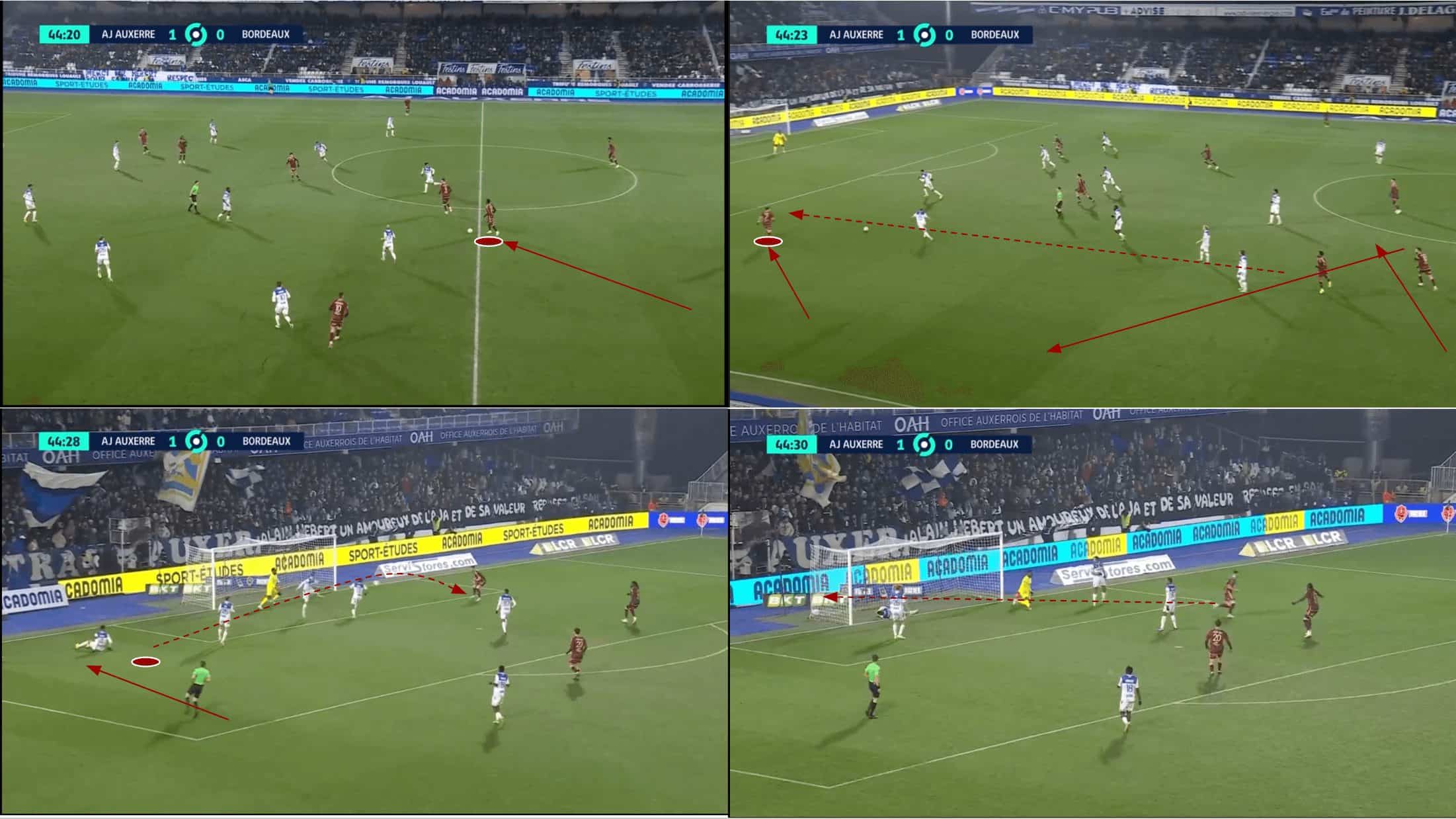
Nsimba split the opposition’s backline open before moving back out wide, rotating with the left central midfielder, Gaétan Weissbeck, as left-winger Jérémy Livolant chases the through ball in behind, plays it across goal low and hard to set up Žan Vipotnik to score.
Progression via the deeper half-space areas, fluid positional rotations to find free men and early penetrative passing have all been vital elements of this Bordeaux side under Riera, which have all been developed significantly during the 41-year-old Spaniard’s tenure.
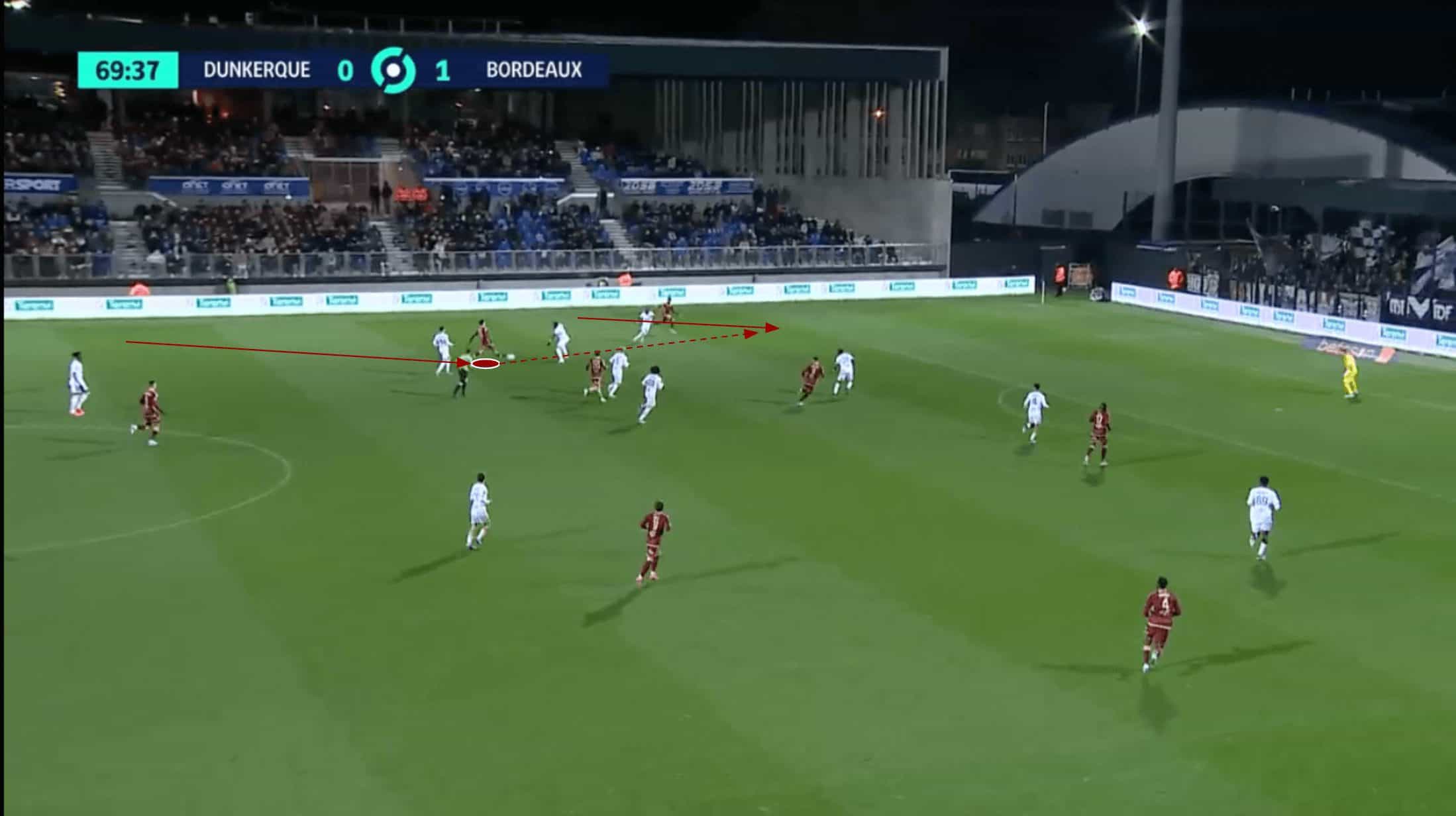
Another example here shows left central midfielder Pedro Díaz setting Nsimba up with a defence-splitting through ball as the left-back overlaps and makes a well-timed curved run around the opposition right-back.
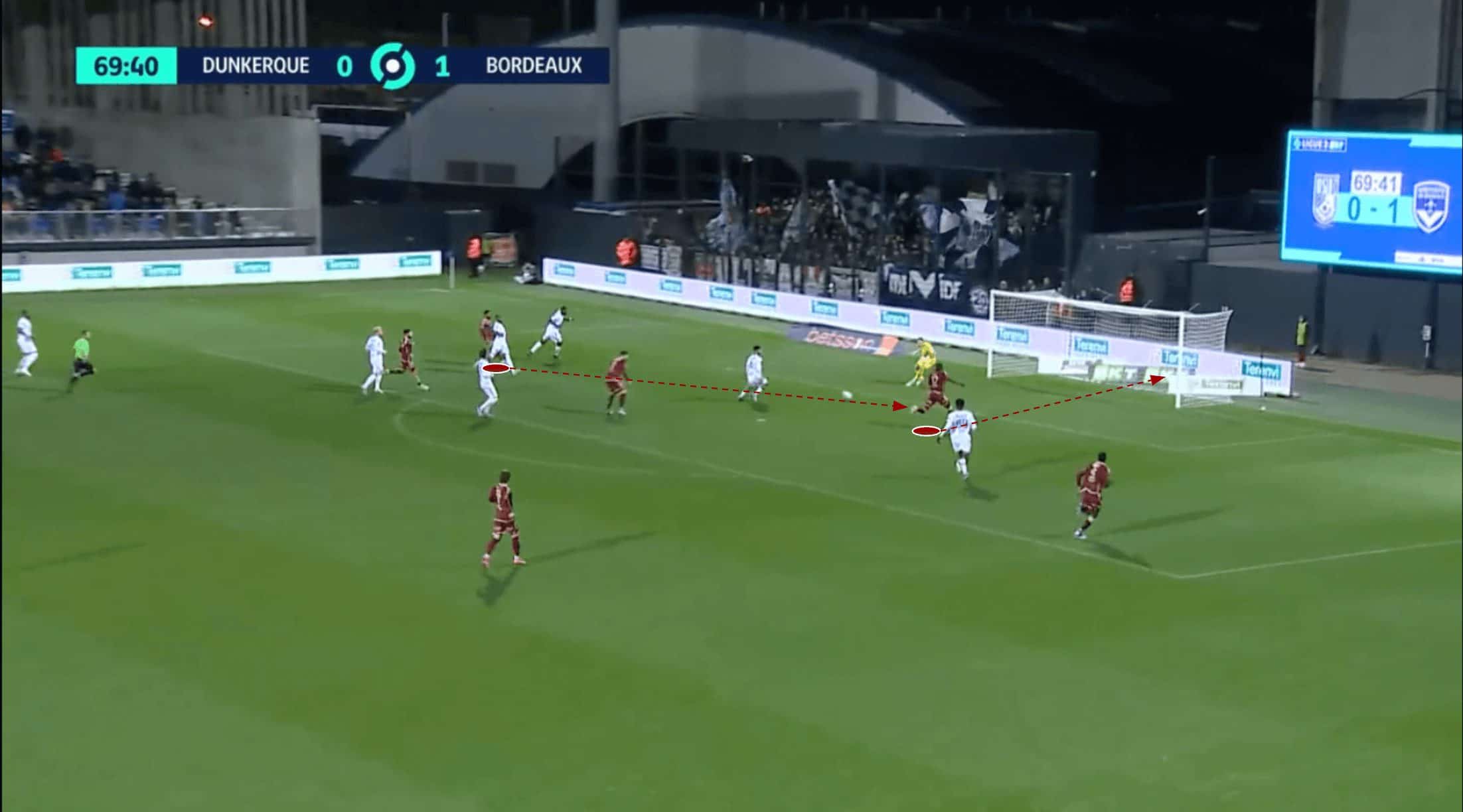
The timing of this pass and Nsimba’s run make it impossible for the full-back to deal with Bordeaux’s threat, allowing Nsimba to receive and drill a low ball across goal for Alberth Elis to convert.
As seen in both of the examples analysed above, low-driven crosses and cutbacks have been a staple of Riera’s Bordeaux in the chance creation phase, just as they were a major part of his Olimpija side last season.
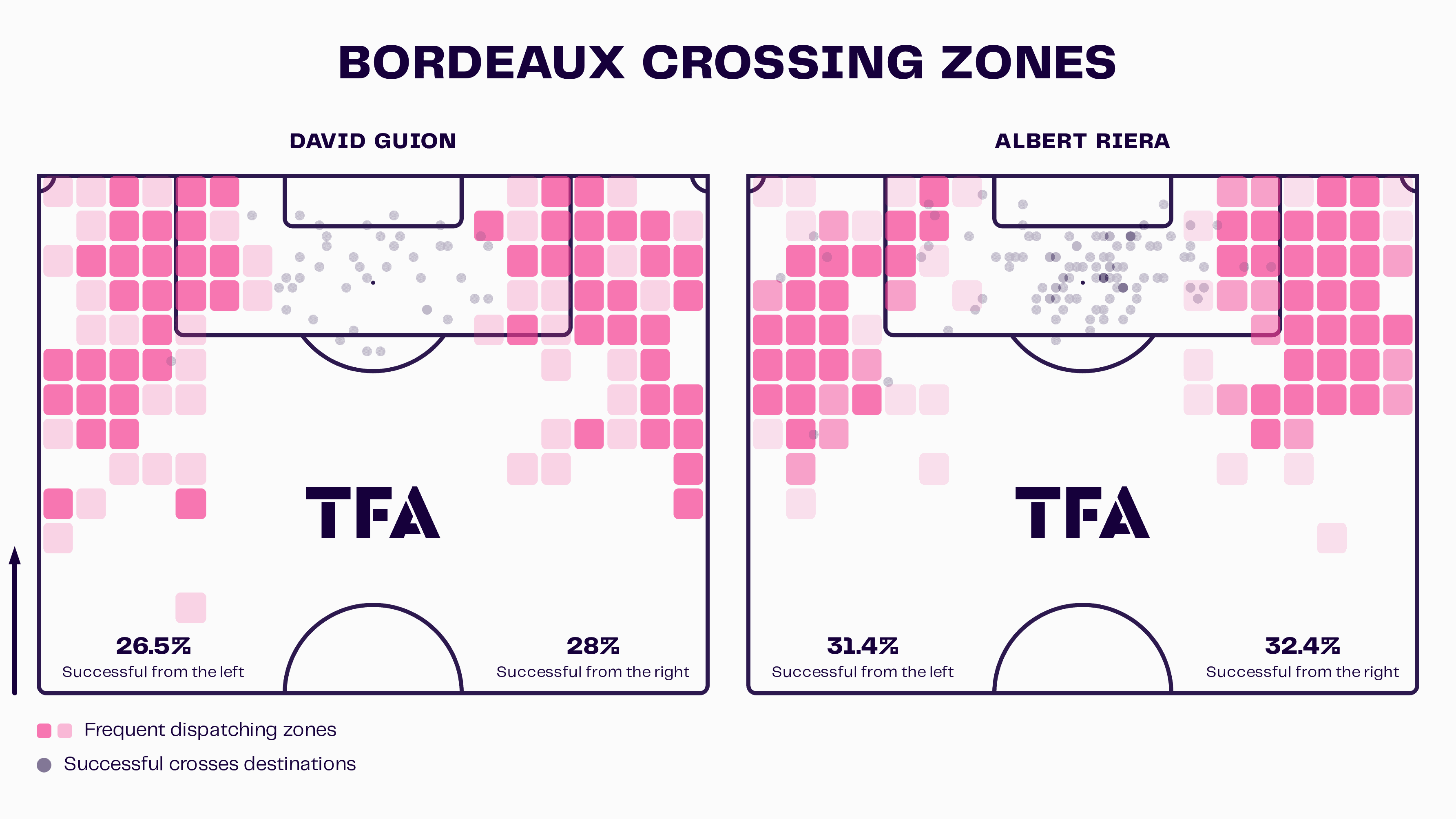
As seen above, Riera’s side has crossed a lot from narrower, more advanced positions, as well as having played fewer crosses from deep and wide under Riera compared with their time under Guion this season.
They’ve seen a nice increase in cross success as well as cross volume (16.375 per 90 now versus 15.0 per 90 before) during Riera’s tenure. Furthermore, it’s notable how Bordeaux’s cross destinations have been more heavily concentrated around the penalty spot during Riera’s tenure compared to the Guion games, which saw cross destinations scattered around the box a bit more.
Riera’s side have been successfully crossing into more valuable areas more consistently than Guion’s side did, essentially, as our viz demonstrates.
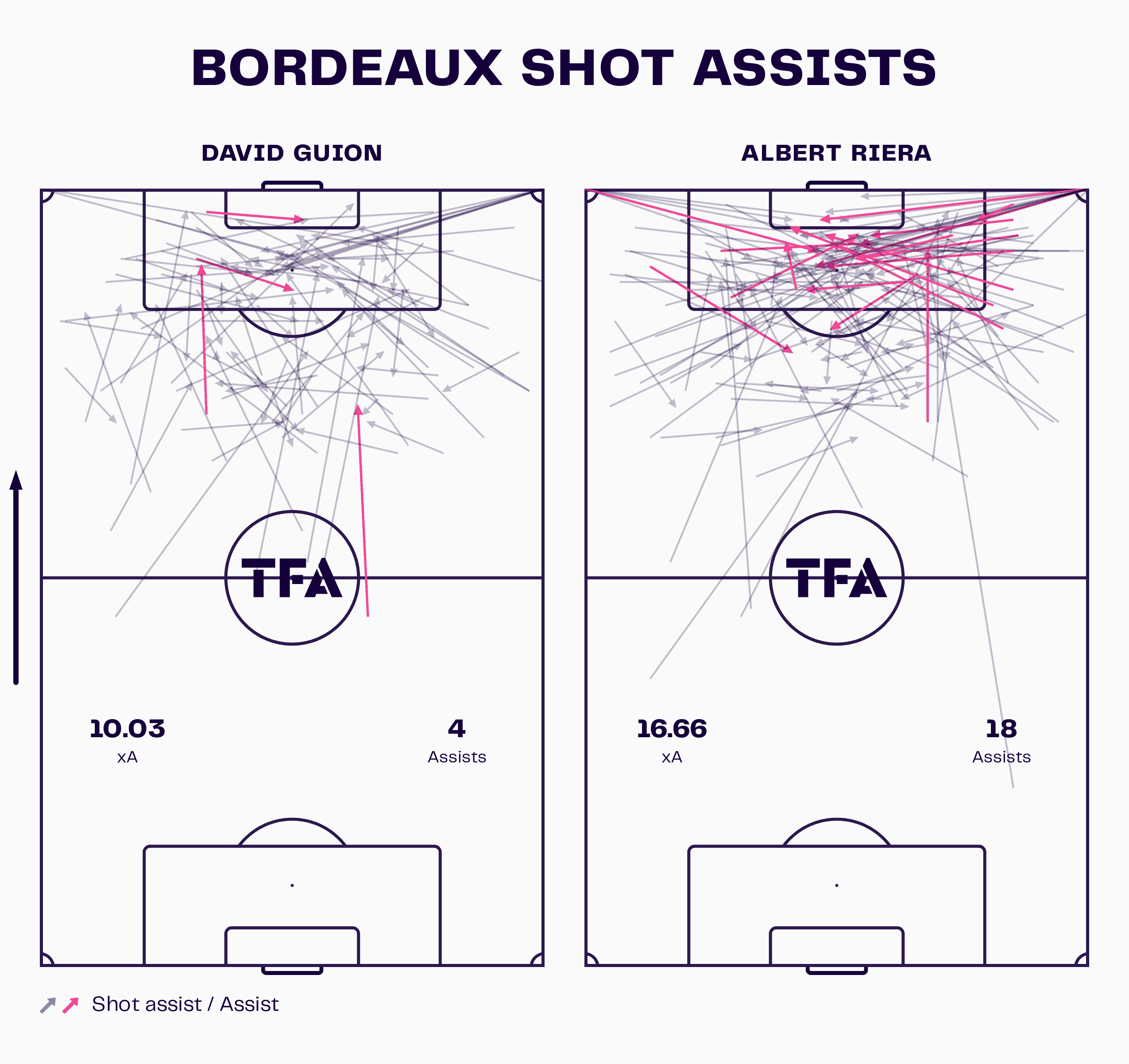
As for their shot assist map, shown in figure 5, again we can see how while chance creation was good under Guion, conversion was poor whereas conversion and chance creation have matched up far better under Riera at Matmut Atlantique.
Again, it’s worth noting how many of Les Girondins’ shot assists came from relatively close to the penalty box or even inside the penalty box — indicative of the critical role low driven balls and cutbacks have played during Riera’s tenure.
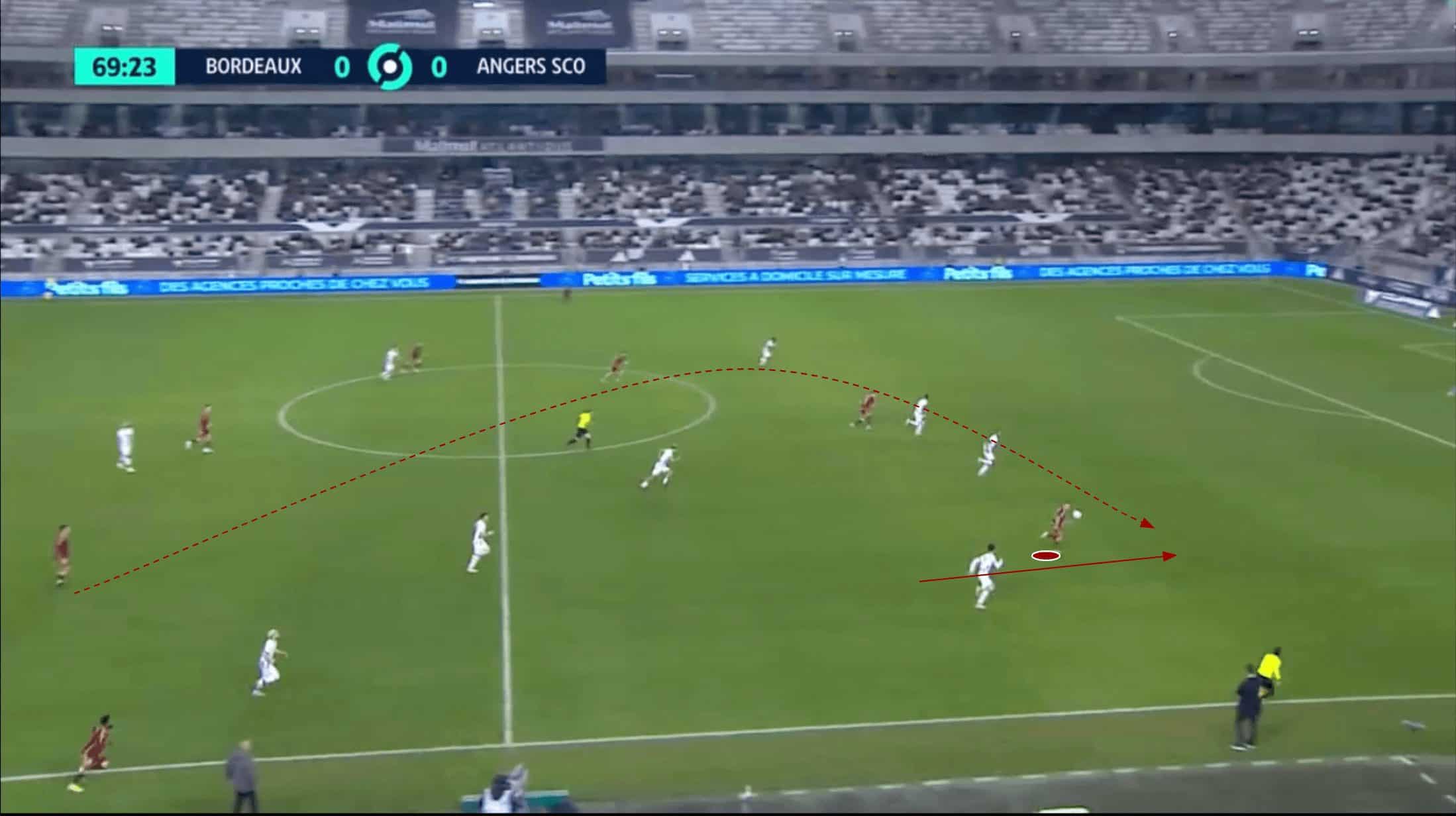
While Riera loves to see his sides dominating the ball — and Bordeaux do typically do that — he’s also very good at crafting lethal counterattacking football, and Bordeaux have excellent wingers, like Elis, Livolant and Zuriko Davitashvili who are well capable of exploiting space behind the opposition’s backline on the counter, as was the case above as Livolant chases a long ball sent in behind Angers’ defence.
Again, Bordeaux are very flexible from a tactical standpoint and shouldn’t be put into any particular box — their approach varies from game to game. While they’ve statistically been the most possession-based side in their division overall, they will approach specific games with different game plans. Against Angers, they set out with a goal of counterattacking and exploiting space they identified would be available behind their opponents’ backline, as they did via the long ball just before figure 6 was taken, showing the dangerous outcome.
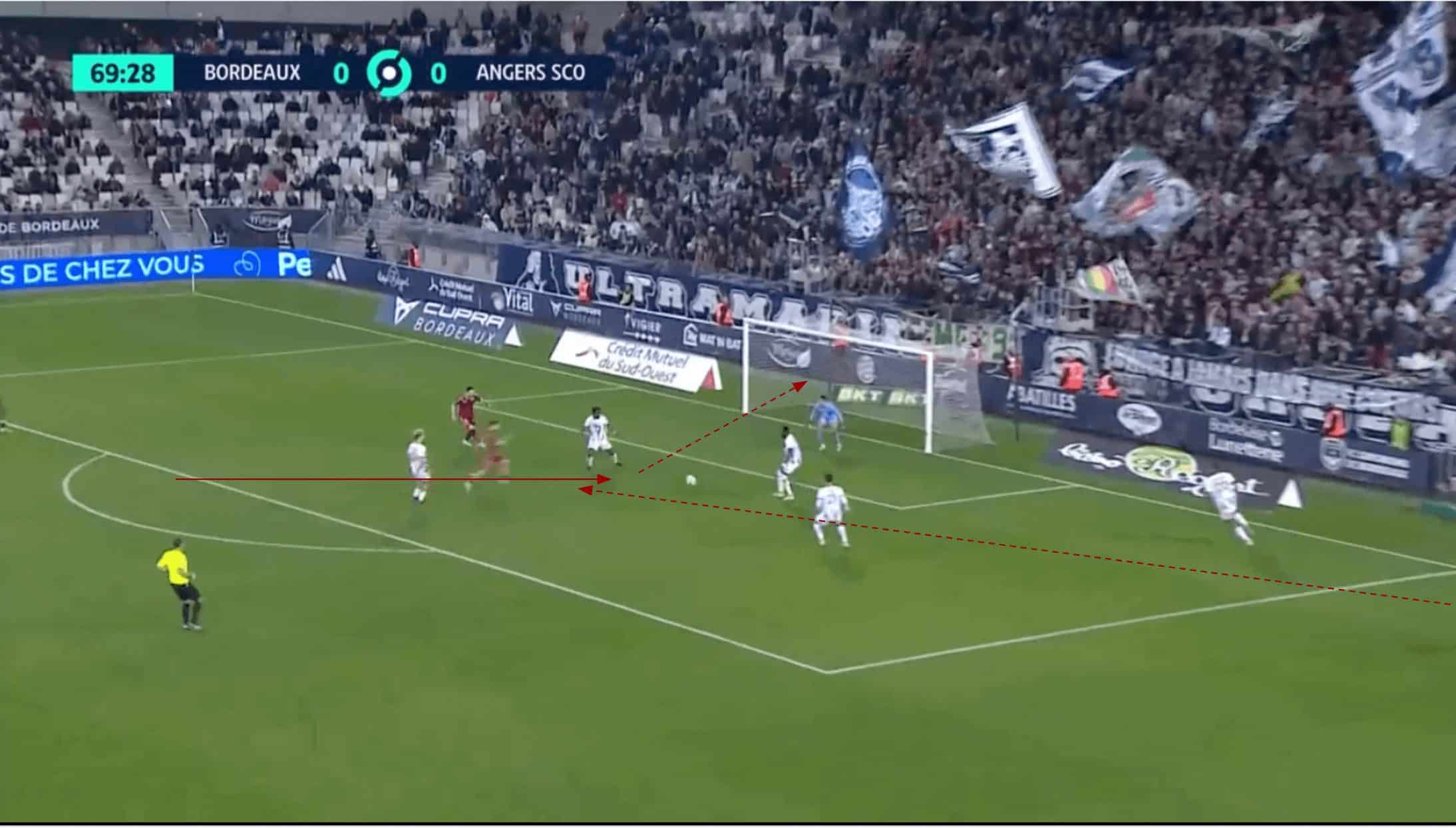
Livolant carried the ball into a good crossing position on the edge of the box, pulled the ball across goal towards the penalty spot where Davitashvili met it and sent it goalward, putting Les Girondins a goal up in the 70th-minute — a lead they would retain until the end of the game, securing all three points.
Despite the obvious counterattacking nature of this attack contrasting somewhat with the positional play principles Riera is known to favour, we catch a glimpse of an even greater principle of this coach’s game here — tactical flexibility based on the opponent.
However, another staple of the team’s game — low crosses towards the penalty spot — is there for us to witness regardless of whether Riera sets his side up in a more counterattacking manner or with the aim of dominating possession and putting together more positional attacks or seeking to pin the opposition in deep by pressing and counterpressing high, generating high turnovers and playing the ball forward.
Regardless of how they’re set up in that regard, flexibility and these crossing methods have been a consistent and valuable feature of this team’s game since Riera’s arrival.
Player roles
Our third and final section will focus on how certain player roles have evolved and developed during Riera’s tenure as Bordeaux boss compared to before. We aren’t going to look at every player in the squad here, but we’ve selected a few whose roles are worth analysing when it comes to contrasting Riera’s Bordeaux with Guion’s.
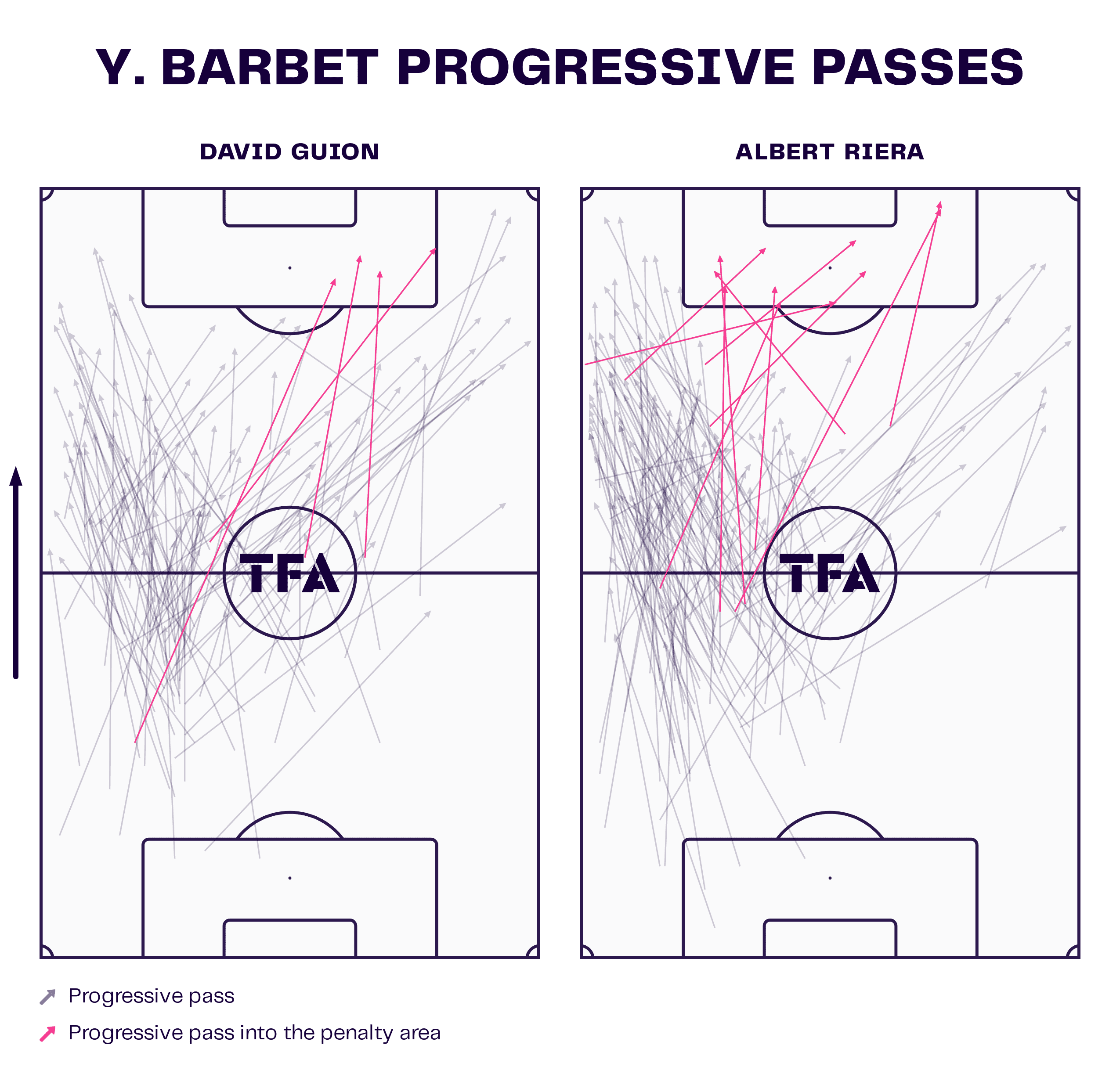
Firstly, centre-back and captain Yoann Barbet has been a stalwart at the left centre-back position for both of the team’s managers this season. Switching play was a more important feature of Barbet’s game under Guion. In contrast, this type of pass has been less prolific under Riera, where passes along the left directed through the inside-left channel have taken centre stage.
Again, the growth in prominence of this type of pass results from the changes in the types of runs being made in behind the opposition’s backline from wide which the deeper players positioned in the half-space will be constantly looking out for, similar to the passes analysed in figures 1 and 2.
Barbet has adapted to the change in circumstances well and remains the key progressive passer in this team under Riera, just as he was under Guion, though in different ways.
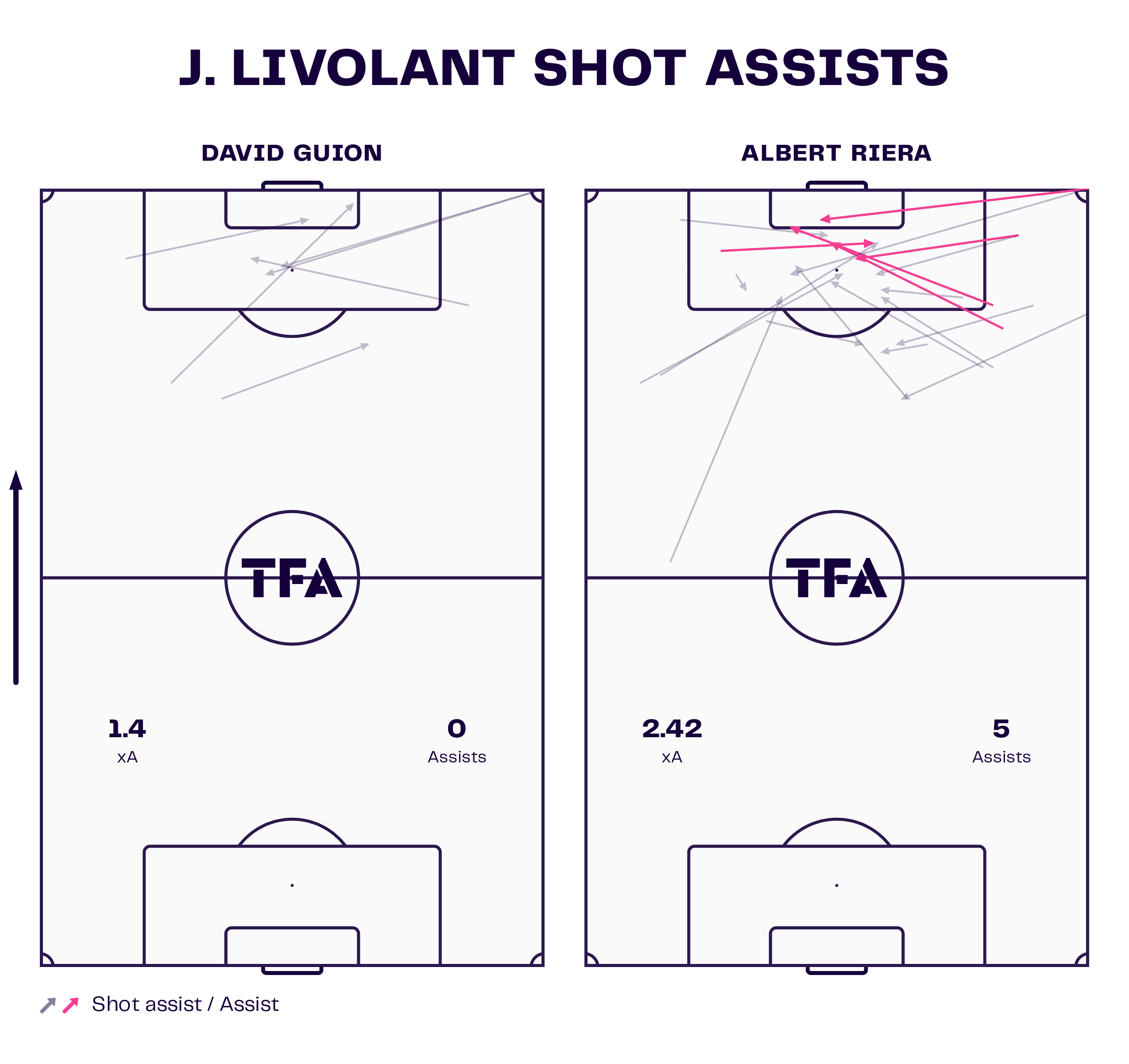
Next up, Livolant has played as a versatile winger, featuring on both the left and right, under Guion and Riera. However, the aforementioned changes in Bordeaux’s chance creation under the 41-year-old Spaniard currently leading them have suited him well, leading to all five of his Ligue 2 assists this season.
Four of the five have resulted from the types of crosses Riera has primarily focused on getting his side delivering regularly. At the same time, the other came from a set-piece — another area Riera has overseen significant progress in order to make some marginal gains since taking the reins back in October.
Livolant has clearly benefitted from working with Riera and vice versa; the pairing is a good match that will ultimately combine well for the club.
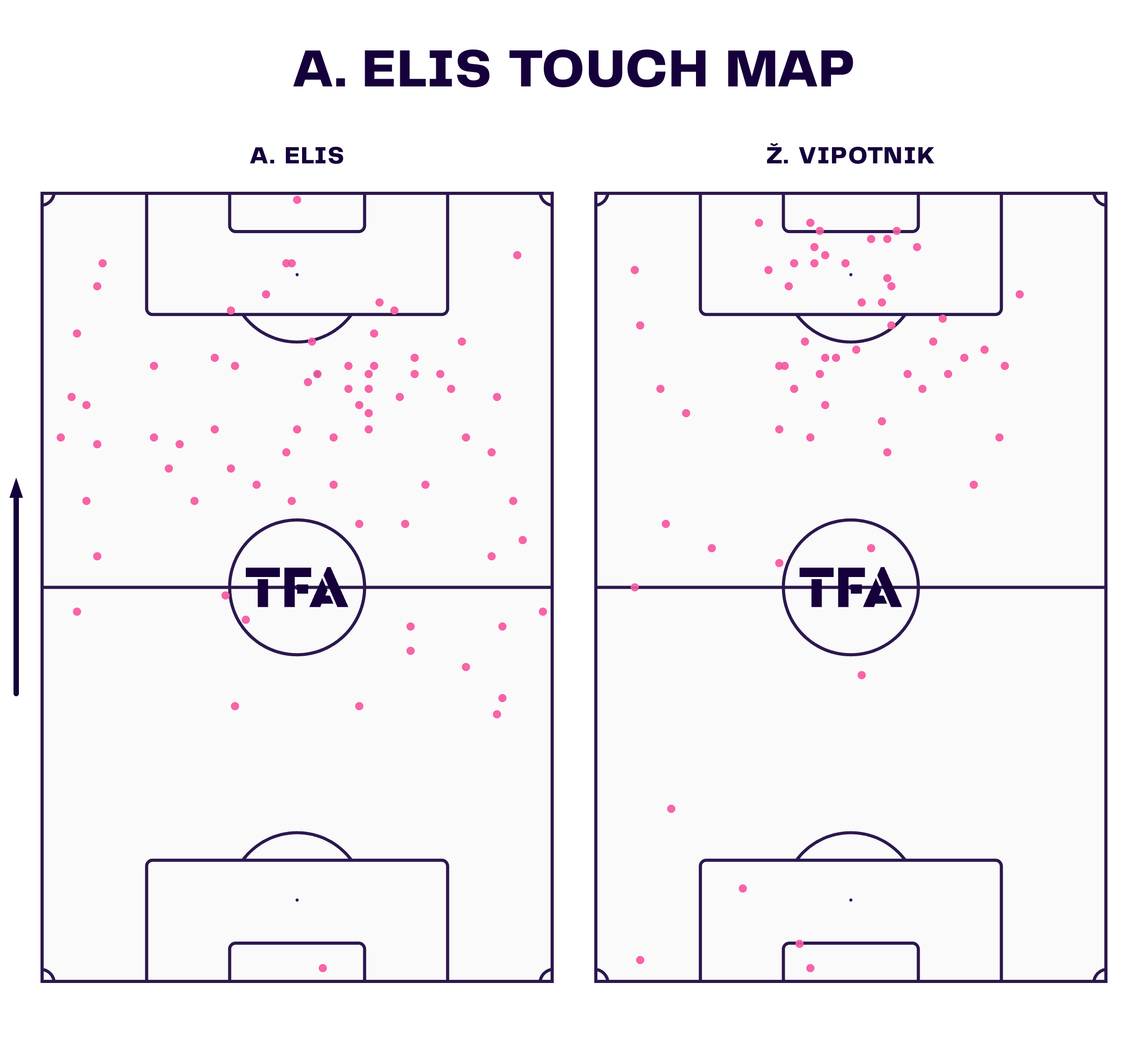
Lastly, Alberth Elis, though primarily a winger, has been deployed as a centre-forward by Riera on several occasions.
While Vipotnik has been Riera’s main centre-forward throughout his time at Bordeaux thus far, in Elis, he gets a completely different central option who likes to drop off and play more as a false 9 in contrast to Vipotnik, who is a typical ‘9’ you’ll almost exclusively find operating inside the box.
Both have enjoyed some success in the centre of attack for Bordeaux this season. Elis’ adaptation to the role has been a big bonus for Riera, who enjoys experimenting with players and the tactical flexibility these two different types of attackers provide.
The pair’s respective touch maps in figure 10 highlight how their involvement differs when deployed as centre-forwards and what Riera asks of each man in their respective roles.
Conclusion
To conclude our tactical analysis, it’s evident that Riera may well be in the process of adding another impressive piece of work to his short but impressive young managerial track record, with Bordeaux clearly on the up under the tutelage of their former player.
Tactical flexibility, cutbacks, half-space penetration from high and deep, as well as some brave experimentation with player roles, have been vital elements of Riera’s Bordeaux, which have combined to make them a formidable outfit in recent weeks. For fans of Les Girondins who’ll feel their club belongs at a higher level, long may this resurgence continue!





Comments